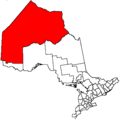Wabigoon Lake Ojibway Nation
| Wabigoon Lake 27 | |
|---|---|
| Indian reserve | |
| Wabigoon Lake Indian Reserve No. 27 | |
 Wabigoon Lake 27 | |
| Coordinates: 49°37′N 92°32′W / 49.617°N 92.533°WCoordinates: 49°37′N 92°32′W / 49.617°N 92.533°W | |
| Country |
|
| Province |
|
| District | Kenora |
| First Nation | Wabigoon Lake |
| Area[1] | |
| • Land | 46.27 km2 (17.86 sq mi) |
| Population (2011)[1] | |
| • Total | 184 |
| • Density | 4.0/km2 (10/sq mi) |
Wabigoon Lake Ojibway Nation, or commonly as Wabigoon First Nation (Anishinaabemowin: Waabigoniiw Saaga'iganiiw Anishinaabeg), is a Saulteaux First Nation band government who inhabit the Kenora District in northwestern Ontario, Canada. It is approximately 19 km southeast of Dryden, Ontario. As of January 2008, the First Nation had a registered population of 533 people, of which their on-Reserve population was 175.
History
The Wabigoon Lake reserve was first laid out in 1884 and was confirmed by the Ontario government in 1915. Members of the Wabigoon Band of Saulteaux living on the western portion of the Indian Reserve moved away and formed the Eagle Lake First Nation. Those living on the eastern portion of the Reserve officially changed its name to Wabigoon Lake Ojibway Nation on August 7, 1987.
Governance
The First Nation elect their officials through the Act Electoral System, consisting of a Chief and three councillors. The current Chief is Esther Pitchenese, whose two-year term began on September 17th, 2015. The four councillors are Lana Kooshet, Ron Williams, Lisa Kooshet, and Tyson Williams.
As a signatory to Treaty 3, Wabigoon Lake Ojibway Nation is a member of the Bimose Tribal Council, a Regional Chiefs Council, and Grand Council of Treaty 3, a Tribal Political Organization that represents many of First Nation governments in northwesternern Ontario and southeastern Manitoba.
Reserve
The First Nation have reserved for themselves the 5,209.2 hectares (12,872 acres) Wabigoon Lake 27 Indian Reserve.
External links
- Wabigoon Lake Ojibway Nation, official website
- AANDC profile
- profile at Chiefs of Ontario Archived 18 December 2007 at the Wayback Machine.
References
- 1 2 "Wabigoon Lake 27 census profile". 2011 Census of Population. Statistics Canada. Retrieved 25 July 2015.
 |
Wabigoon Lake |  | ||
| Unorganized Kenora | |
Unorganized Kenora | ||
| ||||
| | ||||
| Unorganized Kenora |
